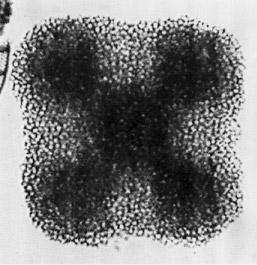 Spongaster
tetras tetras Ehrenberg
Spongaster
tetras tetras Ehrenberg Spongaster
tetras tetras Ehrenberg
Spongaster
tetras tetras EhrenbergSpongaster tetras Ehrenberg, 1860, p.833; 1872b, p.299, pl.IV(iii), fig.8
Spongaster tetras tetras Ehrenberg, Nigrini, 1967, p.41, pl.5, figs.1a-1b (with synonymy); Riedel and Sanfilippo, 1978a, p.74, pl.2, figs.2-3
Shell is a square with rounded corners. Four spongy, pear-shaped "arms" approximately at right angles, are regularly placed in one plane around 5 concentric lattice spheres. A completely enveloping patagium usually makes the central spheres difficult to see, and, at best, 5 concentric rings can be recognized; the "arms" appear merely as dark patches.
Patagium is, for the most part, a dense irregular spongy meshwork with small subcircular pores, but around the "arms" bars become thicker and 3-bladed. In some specimens radial beams apparently form a basis for the patagium, which will then have a radially striated border. Patagium may be depressed slightly around the central structure, but at its periphery its thickness is ~0.25 the length of the sides of the square (Nigrini, 1967).
Distance between sides 150-302 µm (usually 150-276 µm); diagonal 187-369 µm (usually 187-316 µm) (Nigrini, 1967).
Diagonal width 160-370 µm (Sanfilippo et al., 1985).
S. tetras is distinguished from S. pentas by having generally four rather than five or six rays. In some core sequences, occasional assemblages within the stratigraphic range of S. tetras contain rare five-rayed individuals, and therefore identifications based on single specimens can be unreliable (Riedel and Sanfilippo, 1978a).
S. tetras tetras is distinguished from S. tetras irregularis (Nigrini, 1967, p.43, pl.5, fig.2) by its square rather than rectangular shell.
S. tetras is a quadrangular (rarely pentagonal) spongy disk, with thickened or denser zones, corresponding to the angles and in the center. The outline between the corners may be straight, resulting in a rectangular perimeter, or curved inward to produce a lobed one. Quadrangular (rarely pentagonal) specimens with density uniform throughout are also admitted (Sanfilippo et al., 1985).
This extant species is found in late Pliocene to Quaternary sediments from all latitudes less than 40°, except DSDP 206 near New Zealand and 362 off SW Africa. Its evolutionary transition from Spongaster pentas lies within the Spongaster pentas Zone. Its morphotypic first appearance is a reliable and easily recognizable synchronous event. In latitudes higher than about 30°, the square subspecies S. tetras tetras is absent, and only the rectangular subspecies S. tetras irregularis (Nigrini, 1967, p.43, pl.5, fig.2) occurs.
S. tetras evolved from S. pentas, and remains extant.
Additional illustrations can be found in Riedel and Sanfilippo, 1971, pl.1D, figs.2-4.
Benson's (1966) description of this species (p.238) is consistent with the above, but his dimensions are generally smaller (e.g., length of diagonal 127-196 µm), which may reflect lack of affinity for restricted water masses such as the Gulf of California.